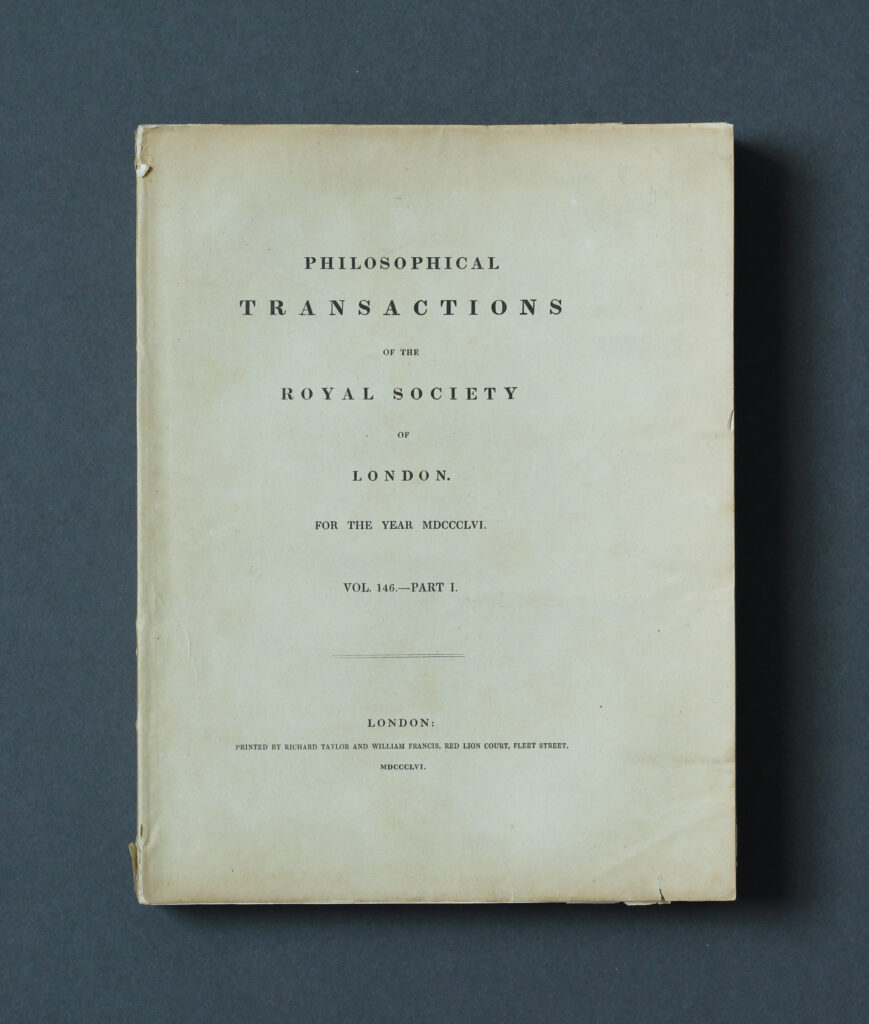THE CONCLUSION OF FARADAY’S GROUND-BREAKING ‘EXPERIMENTAL RESEARCHES IN ELECTRICITY’
IN THE ORIGINAL WRAPPERS WITH VIRTUALLY ALL QUIRES UNOPENED
FARADAY, Michael. ‘Experimental Researches in Electricity – Thirtieth Series’, in: Philosophical Transactions of the Royal Society of London. For the Year MDCCCLVI. Vol. 146. – Part I, pp. 159-180. London: Richard Taylor and William Francis [for the Royal Society], 1856.
Quarto (297 x 228mm), pp. x (title, blank, advertisement, list of recipients of copies and subscribers, blank, contents), 418, [2 (blank l.)]. 8 lithographic plates and maps by J. Basire, W. Lens Aldous, and George West after West et al., printed by Day & Son et al., 5 engraved plates and maps by James Basire III after Lionel Beale et al., and 2 engraved graphs by Basire, one folding. Letterpress tables (some full-page) and wood-engraved illustrations and diagrams in the text. (Very occasional light spotting, heavier on a few plates, short marginal tear on title due to clumsy opening, pl. IX with short tear, pl. XIII detached but present.) Original grey printed wrappers, entirely uncut and (apart from a few quires) entirely unopened. (Wrappers lightly browned and marked, extremities slightly bumped, short tear on upper wrapper, spine-ends with short splits causing small losses at foot.) A very good, fresh copy in the original wrappers. Provenance: [?]early-20th-century manuscript volume number on spine.

First edition. Faraday (1791-1867), was employed as a fourteen-year-old apprentice bookbinder by the bookseller George Ribeau, and he first encountered science when one of Ribeau’s customers gave him tickets to attend four of the final lectures delivered by Humphry Davy, the professor of chemistry at the Royal Institution, in 1812. Faraday’s subsequent scientific career started as an assistant at the laboratory of the Royal Institution, of which he would become the director in 1825. By the time of the publication of this present paper he had achieved international renown, which was reflected in numerous awards and honours, including fellowship of the Royal Society, membership of the Prussian order of merit and the French Légion d’honneur, etc. Published in 1856, and thus during a period of exceptional activity and innovation within the circles of the Royal Society, this issue of the Philosophical Transactionsconcludes Faraday’s ground-breaking series of ‘Experimental Researches in Electricity’ – the papers relating his major discoveries in electricity and magnetism.
‘With this work Faraday […] perfected his methodical way of recording and keeping control of his experimental results. On 25 August 1832 he commenced numbering the paragraphs of his laboratory notebook in a sequence that would conclude on 6 March 1860 with paragraph 16,041. He would cross-refer between entries and on at least two occasions he compiled indexes allowing him quickly to locate the results of experiments conducted many years previously. Faraday published his induction work in the first of a series of papers with the overarching title Experimental Researches in Electricity. The papers were nearly all published in the Philosophical Transactions and their paragraphs also were sequentially numbered ending with paragraph 3430 of series thirty in 1856’ (ODNB). Most of these papers were then collected in Faraday’s Experimental Researches in Electricity, which was published in three volumes between 1839 and 1855 (concluding with paragraph 3234), and ‘encompasses the entire range of Faraday’s remarkable achievement, including his discovery of electromagnetic induction, his demonstration of the identity of all forms of electricity, his first general theory of electricity as a function of interparticulate strain, and the last series of researches on magnetism, containing the germ of modern field theory, in which Faraday rejected his earlier model of the transmission of magnetic energy in favour of one locating the manifestation of magnetic energy in the field surrounding the magnet’ (Norman 762). The present ‘Thirtieth Series’, which was read to the Royal Society on 15 and 22 November 1855, comprised paragraphs 3363 to 3430 and was first published in this volume of Philosophical Transactions in 1856, the year after the publication of final volume of Experimental Researches in Electricity, and thus it forms both a supplement and a conclusion to the series.
Other works in this volume include a paper by the Irish chemist and physicist Thomas Andrews ‘On the Constitution and Properties of Ozone’ – Andrews ‘proved that ozone is a form of oxygen’ (Encyclopaedia Britannica), with this paper (likely the first to propose this theory) concluding that ‘ozone, from whatever source derived, is one and the same body, having identical properties and the same constitution, and is not a compound body, but oxygen in an altered or allotropic condition’ (p. 13); a paper by Humphrey Davy’s brother John, a surgeon and naturalist whose help Darwin enlisted on the question of the survival of fertilised salmon eggs (‘Some Observations on the Ova of the Salmon, in Relation to the Distribution of Species; in a Letter Addressed to Charles Darwin’); three articles by the mathematician and astronomer George Biddell Airy, who had invented the first successful mechanical system of compass correction in 1838 (‘Discussion of the Observed Deviations of the Compass in several Ships, Wood-built and Iron-built…’, ‘Account of Pendulum Experiments undertaken in the Harton Colliery…’ and its ‘Supplement’); the Irish-born natural philosopher John Tyndall’s ‘Further Researches on the Polarity of the Diamagnetic Force’, which continued his argument with Faraday, who had discovered diamagnetism in 1845; and James Prescott Joule’s ‘Introductory Research on the Induction of Magnetism by Electrical Currents’ (i.e. electromagnetism).
£149.50
· · · · · · · · · · · · · · · · · · · · · · · · · ·
Our Terms & Conditions apply

